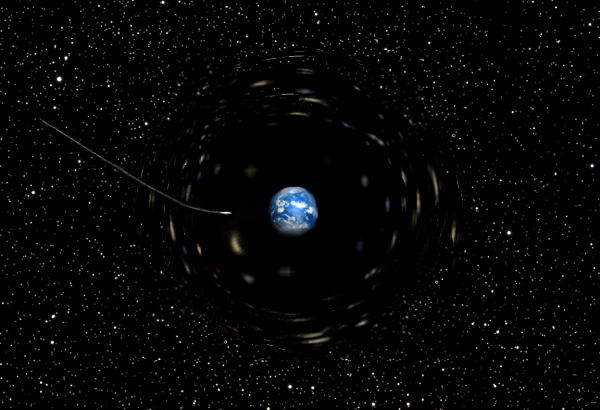BY LETTER
Baryos
Culture and Society > Myths and the Unexplained > Artefacts (Artifacts)
Galactography > Systems and Worlds > Systems & Worlds A - B
Galactography > Systems and Worlds > Systems & Worlds A - B
 Image from Steve Bowers | |
| The strong gravity field around Baryos can be observed directly through gravitational lensing. Comets and meteors strike frequently and with great force | |
The explanation was unusual: the planet was located in the core of a neutrino star. Neutrinos seldom interact with normal matter, but have a positive mass. A sufficiently large and cold mass of neutrinos can form an invisible cloud held together by gravity. No other examples of neutrino stars have been observed, and the general view is that the object is of artificial origin.
Gravity on the surface of Baryos is just 1.2 G, since the gravity depends only on the mass inside the radius where it is measured. However, the moon Tachys orbiting 450,000 kilometres away experiences the gravity of nearly one sun mass, making an orbit in just 57 minutes. The escape velocity from Baryos is 10,000 kilometres per second.
Baryos is covered with a deep ocean, with an average depth of 6 kilometres. The depth is likely due to a large influx of cometary ice through history. The fact that it is just a terrestrial world and not a major gas giant suggests that the neutrino star was formed after Baryos was formed, either around it or catching the planet into its current orbit.
Baryos has a large cross section for infalling matter, making meteor impacts common. Since the meteors are accelerated by the neutrino mass they tend to be very energetic. The oceans tend to absorb the impacts, but water vapour clouds often make the climate fluctuate strongly after an impact.
Life on Baryos is not very special, typical aquatic life based on left-handed amino acids, a three-stranded nucleic acid using six nucleotides, with starches doing many functions performed by proteins in terrestrial life. A rich biosphere of pelagic creatures exist, with titanic filter-feeding "whales" grazing algae fields, various hunting swimmers, migrating hive-like schools of small creatures and a complex ecology of scavengers on the seafloor. The occasional meteor impacts have caused mass extinctions, but in general the ecosystem appears to be very resilient. No species with highly developed intelligence have been observed, and it is unlikely that any will evolve due to limitations on baryan neurochemistry.
In the end, Baryos stands as yet another of the wonders of the galaxy. Either it is an exceedingly unlikely coincidence, or a deliberate creation of aliens with an unknown purpose. It has been suggested that Baryos is everything from an artwork to a warning to a prison, but absolutely no evidence supports any conclusion.
Appears in Topics
Development Notes
Text by Anders Sandberg
Initially published on 08 October 2001.
Initially published on 08 October 2001.






